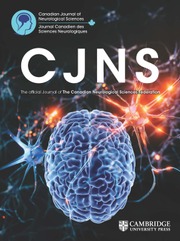Chronic subdural hematoma (cSDH) is a common pathology in older individuals and is a significant cause of mortality. These hematomas are challenging to effectively treat to achieve complete and sustained resolution, which can otherwise be profoundly symptomatic as well as potentially life threatening. Surgical drainage of symptomatic subdural collections remains the mainstay of treatment; however, recent landmark clinical trial evidence supports endovascular approaches targeting the putative underlying pathogenesis of cSDH. Reference Davies, Knopman and Mokin1–Reference Liu, Ni and Zuo3 Distinct from the pathogenesis of acute hemorrhages, cSDH is proposed to result from chronic inflammatory-mediated neoangiogenesis involving the dura Reference Edlmann, Giorgi-Coll, Whitfield, Carpenter and Hutchinson4 including involvement of vascular endothelial growth factor (VEGF) pathways. The endovascular treatment approach consists of middle meningeal artery embolization to prevent abnormal friable dural vessels from further bleeding. However, there is no specific imaging modality for the pre-intervention patient selection or for prognostication of treatment efficacy in patients with cSDH. Prostate-specific membrane antigen (PSMA) positron emission tomography (PET) (both 68Ga and 18F derivatives) can visualize VEGF angiogenesis, which has been exploited in the imaging of certain intracranial pathologies including glioblastoma, Reference Brenner, Strobel and Prasad5 and thus may have a significant application for cSDH.
Highlighted is a case of a patient presenting for a 68Ga PSMA-11 PET/CT due to the incidental discovery of sclerotic osseous lesions on prior anatomical imaging with biochemical concern for prostate cancer. There is diffuse uptake in the region of the right skull (Figure 1A). PET/CT fused images determined that the uptake corresponded to the extra-axial CSF space at the right cerebral convexity (Figure 1B–D). Correlation with prior dedicated anatomic imaging confirmed the uptake corresponded to a persistent cSDH (Figure 1E). No PSMA-avid prostatic metastatic disease was identified.

Figure 1. 68Ga-PSMA PET demonstrating uptake in a chronic subdural hematoma (red arrows). (A) maximum intensity projection PET image demonstrating curvilinear uptake associated with the right calvarial region. (B) PET demonstrating crescentic extra-axial uptake correlating to a (C) relatively isodense subdural collection. (D) Fused PET/CT demonstrates that this residual subdural collection has reduced in size but is persistent compared to the presurgical prior anatomical CT (E), which demonstrated both hyperdense acute (yellow arrow) and hypodense chronic (red arrowhead) hematoma components at that time.
This is the first description of 68Ga-PSMA uptake associated with subdural hemorrhage. Case reports however exist for the 18F PSMA derivatives, and therefore, both 18F and 68Ga PSMA can be expected to have similar uptake. The mechanism of uptake is hypothesized to be related to inflammatory-mediated dural neoangiogenesis, the key pathologic process underlying cSDH, mediated by VEGF. Nonspecific extravasation of the circulating radiopharmaceutical likely does not significantly contribute to the localization in cSDH, given the absence of uptake with other tracers, such as 18F-flurorodeoxyglucose. Thus, specific visualization of angiogenesis related to cSDH could have a profound impact on the management of these patients as to date, no imaging study is routinely used to assess this process. Studies on cSDH incorporating PSMA imaging are crucial to further elucidate the mechanism of uptake and determine the impact of this PET imaging approach for the management of these patients. Ultimately, with a paucity of specific imaging approaches for evaluation of cSDH, PSMA PET is a promising biomarker for prognostication and patient selection for surgical and/or endovascular intervention.
Author contributions
IRM was responsible for all aspects of the manuscript.
Funding statement
No funding support was received for this work.
Competing interests
No potential conflict of interest relevant to this article was reported.


